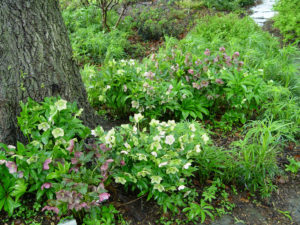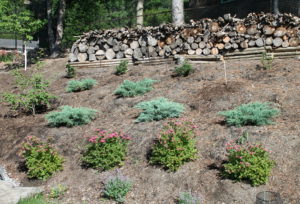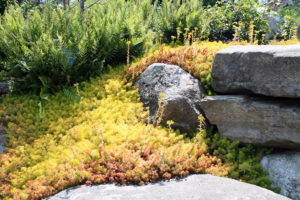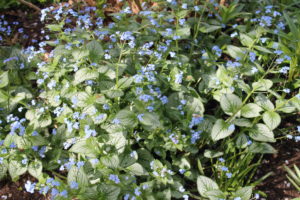Solution Gardening 2: More Plants to Solve Yard Problems
Author and retired horticulture professor Dr. Allan Armitage’s plant-buying theory is that most people don’t go to the garden center looking for certain plants.
They go to carry out a gardening project or to solve a yard problem.
His intriguing suggestion is that maybe plant-sellers should start displaying plants by the situations they address instead of the traditional way of lining up plants alphabetically by their type.
He dubs the idea “solution gardening.”
Unless/until Armitage’s solution-gardening suggestion catches on, I thought I’d weigh in with Pennsylvania-geared solution-gardening lists of perennials, shrubs, and evergreens.
Here’s my second collection of seven of the more common issues:
Plants for Blocking Unwanted Views
Small Trees: American fringe tree, Carolina silverbell, cherry ‘Okame,’ columnar hornbeam, crabapple, dogwood, dwarf magnolia, flowering cherry, hawthorn, hop hornbeam, Japanese tree lilac, paperbark maple, Persian parrotia, redbud, serviceberry, smoketree, stewartia, sweetbay magnolia, three-flower maple, trident maple, witch hazel
Tall Shrubs: beautybush, chokeberry, crape myrtle, elderberry, lilac, oakleaf and panicle hydrangeas, ninebark, red-twig dogwood, sterile varieties of butterfly bush and rose of Sharon, sumac, sweetshrub, viburnum, winterberry holly
Evergreens: arborvitae, Bosnian or Swiss stone pines, boxwood ‘Dee Runk,’ cryptomeria, greenthread/goldthread falsecypress, fir (except disease-prone Douglas fir), Hinoki cypress, holly, juniper, Manhattan euonymus, rhododendron, spruce, upright yew
Plants for Sunny, Open Slopes and Hillsides
Perennials: agastache, allium, amsonia, aster, baptisia, beebalm, betony, black-eyed susan, butterfly weed, catmint, coreopsis, daylily, dianthus, euphorbia, gaillardia, gaura, goldenrod, hardy geranium, heliopsis, iris, lavender, liatris, mountain mint, mums, ornamental grasses, penstemon, perennial sunflower, purple coneflower, Russian sage, salvia, sedum, Shasta daisy, tall garden phlox, yarrow, yucca
Shrubs: abelia, beautyberry, bush honeysuckle, caryopteris, deutzia, forsythia, lilac, ninebark, panicle hydrangea, shrub roses, spirea, St. Johnswort, stephanandra, sterile butterfly bush, sumac, sweetshrub, viburnum, Virginia sweetspire, weigela, winterberry holly, witch hazel
Evergreens: arborvitae, dwarf cryptomeria, fir (except disease-prone Douglas fir), greenthread/goldthread falsecypress, Hinoki cypress, holly, juniper, nandina, spruce, yew
Trees that Aren’t Big or “Messy”
Leaf-Dropping Trees: American fringe tree, Carolina silverbell, columnar hornbeam, cutleaf Japanese maple, smoketree, crape myrtle, Japanese tree lilac, redbud, Rutgers hybrid dogwoods, Persian parrotia, witch hazel
Evergreens: dwarf arborvitae, dwarf cryptomeria, Hinoki cypress, holly ‘Dragon Lady’ and Red Beauty, dwarf blue spruce, greenthread/goldthread falsecypress, juniper, Korean fir, upright yew
Plants for Pollinators
Annuals: ageratum, alyssum, blue salvia, cleome, cosmos, dahlia, daisies, gomphrena, heliotrope, lantana, marigold, nicotiana, pentas, petunia, sunflower, verbena, zinnia
Perennials: agastache, amsonia, aster, baptisia, beebalm, betony, black-eyed susan, butterfly weed, cardinal flower, catmint, columbine, coralbells, coreopsis, culver’s root, gaillardia, golden ragwort, goldenrod, heliopsis, ironweed, Joe Pye weed, lavender, liatris, meadow rue, mountain mint, mums (some), penstemon, purple coneflower, rattlesnake master, salvia, sedum, silphium, sneezeweed, swamp milkweed, stokesia, tall garden phlox, turtlehead, veronica, wild bergamot, yarrow
Shrubs: abelia, bayberry, blueberry, buttonbush, chokeberry, deutzia, elderberry, fothergilla, ninebark, New Jersey tea, oakleaf hydrangea, red-osier dogwood, summersweet, snowberry, spicebush, sumac, viburnum, winterberry holly, witch hazel
Trees: black gum, dogwood, catalpa, crabapple, flowering cherry, hawthorn, linden, redbud, red maple, serviceberry, seven son flower, tulip tree, willow
Plants that Seldom Get Eaten by Bugs or Animals

Helleborus or “Lenten rose” is a perennial that hardly ever runs into bug, animal, or disease trouble.
Perennials: agastache, allium, amsonia, aster, astilbe, baptisia, barrenwort, beebalm, betony, bleeding heart, brunnera, catmint, coralbells, creeping phlox, euphorbia, ferns, foamybells, gaura, goats beard, goldenrod, hardy geranium, heliopsis, hens and chicks, iris, Japanese anemone, Joe Pye weed, lamb’s ear, lamium, lavender, leadwort, Lenten rose, liatris, mums, ornamental grasses, penstemon, peony, Russian sage, salvia, sedum, Solomon’s seal, turtlehead, yarrow, yucca
Shrubs: abelia, bayberry, beautyberry, beautybush, bush honeysuckle, caryopteris, chokeberry, deutzia, elderberry, forsythia, fothergilla, hydrangea, lilac, ninebark, spirea, St. Johnswort, sterile butterfly bush, sumac, summersweet, sweetshrub, viburnum, Virginia sweetspire, weigela, winterberry holly
Evergreens: birds nest spruce, blue atlas cedar, dwarf cryptomeria, fir, greenthread/goldthread falsecypress, Hinoki cypress, juniper, Oriental spruce, nandina, Russian cypress, sweetbox, weeping Alaska cedar
Groundcovers for Sun
Short Perennials: campanula, candytuft, catmint, coreopsis, creeping phlox, creeping sedum, creeping veronica, dianthus, hardy geranium, hardy ice plant, hens and chicks, lamb’s ear, leadwort, liriope, mazus, oregano, thyme
Low Shrubs: deutzia, dwarf abelia, dwarf and sterile butterfly bush, groundcover roses, lowbush blueberry, St. Johnswort, stephanandra, sumac ‘Gro Low’
Low Evergreens: dwarf nandina, globe arborvitae, spreading juniper, spreading yew
Groundcovers for Shade
Short Perennials: barrenwort, bergenia, brunnera, bunchberry, Chinese astilbe, coralbells, false or variegated Solomon’s seal, ferns, foamflower, foamybells, goats beard, goldenstar, hardy begonia, hardy ginger, hosta, Japanese forest grass, lamium, leadwort, Lenten rose, liriope, pachysandra, sedge (Carex), sweetflag, sweet woodruff, wood aster, woodland stonecrop
Low Shrubs: dwarf summersweet, St. Johnswort
Low Evergreens: boxwood, cotoneaster, Japanese plum yew, Russian cypress, spreading yew, sweetbox
For more on getting the right plant in the right place, see my 18-page “Survivor Plants of Pennsylvania” booklet that zeroes in on hundreds of the best plant varieties with sizes, bloom times, and other important attributes. It’s available as a $5.95 download on my “Buy Helpful Info” page.












